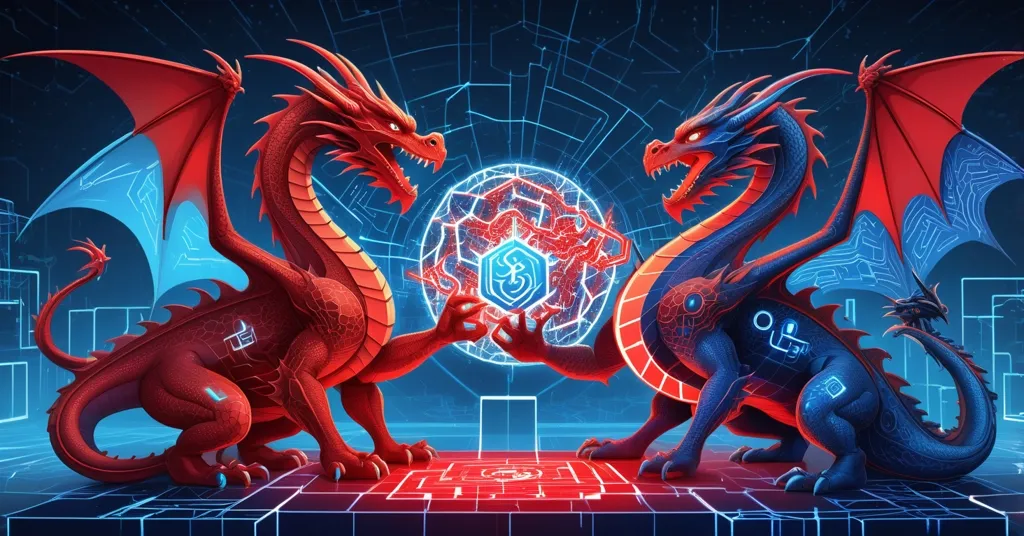Sam Altman Slams Trump’s Chip Ban as China’s AI Surge Threatens Crypto and Blockchain

Sam Altman Warns of China’s AI Surge: Trump’s Chip Ban Stumbles, Crypto Faces Risks
Sam Altman, the candid CEO of OpenAI, has sounded a piercing alarm over the United States’ complacency in the face of China’s aggressive strides in artificial intelligence (AI), slamming Donald Trump’s latest chip export ban as a flimsy roadblock that’s failing to halt Beijing’s tech juggernaut. As tensions in the U.S.-China tech war flare, Altman’s critique raises urgent questions not just for AI, but for the decentralized realms of cryptocurrency and blockchain where hardware and trust are battlegrounds of their own.
- China’s AI Dominance: Altman highlights China’s rapid buildout of a full-stack AI ecosystem, outpacing U.S. efforts in key areas.
- U.S. Policy Missteps: Trump’s chip export restrictions are faltering, potentially speeding China’s self-reliance with firms like Huawei.
- Crypto at Stake: This tech rivalry could disrupt blockchain hardware supply chains and fuel centralized control over digital systems.
Trump’s Chip Ban: A Leaky Defense Against China’s Tech Rise
In April 2025, Donald Trump escalated a long-standing U.S. strategy to curb China’s technological ascent by imposing a sweeping ban on high-end chip exports, building on earlier restrictions from the Biden administration. This wasn’t a mere policy tweak—it outright blocked even modified chips crafted to dodge prior rules, aiming to strangle China’s access to the cutting-edge hardware vital for AI development. Yet, just last week, the administration flipped the script, greenlighting Nvidia and AMD to sell “China-safe” chips under a new deal that demands 15% of their China-generated revenue be funneled back to the U.S. government. Trump waved off Nvidia’s H20 chip as “obsolete,” but the reversal smells more of economic pragmatism than strategic resolve, especially with projections estimating 1.5 million H20 units could ship to China in 2025 if unrestricted.
Altman isn’t impressed with this game of whack-a-mole. His frustration cuts deep as he warns of a far broader threat than just silicon, as detailed in his recent comments on Trump underestimating China’s AI capabilities.
“I’m worried about China. There’s inference capacity, where China probably can build faster. There’s research, there’s product; a lot of layers to the whole thing.”
For those new to the jargon, inference capacity is the ability to run trained AI models in real-world scenarios—like powering chatbots or self-driving cars. It’s the horsepower behind AI applications, and Altman’s point is stark: while the U.S. obsesses over locking down chips, China is constructing an entire AI fortress from raw research to market-ready tools. Worse, he doubts the export bans are even working.
“My instinct is that doesn’t work. You can export-control one thing, but maybe not the right thing… maybe people build fabs or find other workarounds.”
By “fabs,” Altman means chip manufacturing plants—a critical piece of the puzzle China is racing to master. His skepticism isn’t abstract; it’s backed by a messy reality where U.S. policies might be doing more harm than good by pushing China to go it alone, a concern echoed in discussions about U.S. chip ban effectiveness.
China’s Counterpunch: Huawei and Homemade Tech
Beijing isn’t sitting idle while the U.S. plays gatekeeper. Chinese tech giants like Huawei are cranking out domestic alternatives to American hardware at a blistering pace, alarming even the most bullish U.S. strategists. Analysts at Bernstein forecast that China’s share of homemade AI chips could skyrocket from 17% in 2023 to a staggering 55% by 2027. Sure, Huawei isn’t on par with global leaders yet—they’re roughly 3-4 years behind in high-bandwidth memory (HBM), a super-fast memory tech crucial for AI performance, and their production is bottlenecked at an estimated 700,000 units in 2025 against a much larger demand. But the trend is undeniable, as seen in reports on Huawei’s push for domestic tech solutions. Even as titans like ByteDance and Alibaba still hunger for Nvidia’s chips due to their mature ecosystems, China’s government is pushing hard for self-reliance, fueled partly by paranoia over U.S. chips potentially hiding backdoors or remote shutdown features—claims Nvidia denies, but whispers that persist nonetheless.
This pivot to domestic tech isn’t just a middle finger to U.S. policy; it’s a survival strategy. If China’s suspicions about American hardware prove true—or even if they don’t—their march toward independence could render export bans moot. Nvidia CEO Jensen Huang has called Huawei “formidable” and “very close” behind, while Commerce Secretary Howard Lutnick let slip a cynical U.S. tactic of getting Chinese developers “addicted” to American tech stacks. Good luck with that when Beijing’s already building its own sandbox at breakneck speed, a trend well-documented in overviews of China’s AI development race.
OpenAI Strikes Back: Countering Chinese Open-Source Models
Altman’s concerns aren’t just hot air—they’re shaping OpenAI’s playbook. In a bold move, the company recently unveiled two new open-weight models, gpt-oss-120b and gpt-oss-20b, marking their first such release since GPT-2 in 2019. For the uninitiated, open-weight models are AI systems where the pre-trained parameters are publicly available, letting developers run them locally or offline, though OpenAI isn’t sharing the training data or source code. This isn’t altruism; it’s a calculated jab at the rising tide of Chinese open-source tools like DeepSeek and Kimi K2 that are luring developers into Beijing’s orbit, a strategy explored in depth in discussions about OpenAI’s release versus Chinese models.
“It was clear that if we didn’t do it, the world was gonna head to be mostly built on Chinese open source models.”
With Meta’s Mark Zuckerberg hinting at pulling back from releasing open models like Llama, OpenAI is stepping up as the U.S. standard-bearer in this fight for developer allegiance. But let’s not pop the champagne yet—early feedback suggests these models feel underwhelming to some developers due to their stripped-down capabilities. Still, the intent is clear: OpenAI aims to keep the global AI ecosystem tethered to American innovation, even if the execution isn’t flawless.
Why Crypto and Blockchain Should Be on High Alert
Now, let’s pivot to the turf we care about most—cryptocurrency and blockchain. This U.S.-China tech slugfest isn’t some distant drama for AI geeks; it’s a looming storm for the decentralized world. First, consider the hardware angle. China dominates the production of ASIC miners through companies like Bitmain, which controls a hefty chunk of the Bitcoin mining hardware market. If export bans and supply chain fractures escalate, access to critical gear for Bitcoin mining—or even GPUs for Ethereum staking—could get squeezed. We’ve already seen how geopolitical games can disrupt global markets; now imagine a world where your rig’s next upgrade is hostage to a trade war, a risk highlighted in analyses of crypto supply chain vulnerabilities.
Then there’s the bigger, uglier specter of centralization. China’s push for digital dominance, including leveraging AI for surveillance via tools like the digital yuan, mirrors the kind of state overreach Bitcoin was born to resist. If Beijing’s AI infrastructure outstrips the U.S., it could mean tighter control over digital ecosystems—potentially choking blockchain networks under centralized standards or state-backed hardware. On the flip side, this rivalry might just be the fire under our collective backside to accelerate decentralized innovation. Could we see trustless AI models running on Ethereum for DeFi oracles? Might Bitcoin’s permissionless ethos inspire censorship-resistant AI systems as a counter to government overreach? These aren’t pipe dreams; they’re necessities if we’re serious about keeping tech free and open, a topic debated widely on platforms like how China’s AI push impacts crypto.
Let’s not sugarcoat it—the same trust issues haunting AI hardware (backdoors, control, dependency) are old hat for crypto OGs who’ve watched centralized exchanges collapse like houses of cards. China’s rise in AI could be a cautionary tale for relying on any single nation’s tech stack, reinforcing why decentralization isn’t just a slogan but a lifeline. Hell, if Trump’s chip ban is as porous as a failed hard fork, we’d better start building our own untraceable networks before the centralized giants lock us out.
Playing Devil’s Advocate: Do Export Bans Have Hidden Value?
Before we write off U.S. policy entirely, let’s chew on a counterpoint to Altman’s doom-and-gloom. Sure, export controls haven’t stopped China’s momentum—Huawei’s rise proves that—but they might still drain Beijing’s resources in the long haul. Forcing China to pour billions into R&D for domestic chips could slow their broader tech ambitions, buying the U.S. time to regroup. Even if short-term workarounds like “China-safe” chips keep trade flowing, the constant pressure might deter China from fully catching up in critical areas like HBM tech. It’s a long shot, and Altman’s right to call out the immediate failures, but dismissing export bans as pure folly might overlook a slower, strategic grind. For crypto, this delay could mean more breathing room to scale decentralized systems before state-controlled tech fully tightens its grip, a perspective shared in community discussions on Trump’s chip ban impact on tech and crypto.
Key Questions and Takeaways
- How effective are U.S. export controls in slowing China’s AI growth?
They’re largely ineffective in the short term—China’s domestic alternatives like Huawei are gaining ground, and bans may be hastening their self-reliance rather than curbing it. - Why did OpenAI release open-weight models like gpt-oss-120b?
It’s a defensive move to counter the pull of Chinese open-source AI tools like DeepSeek, aiming to keep developers loyal to U.S.-based ecosystems despite mixed feedback on the models. - What does China’s AI surge mean for global tech power?
Unchecked, it could shift the balance toward Chinese infrastructure, redefining AI standards and digital economies in ways that challenge U.S. dominance. - How does the U.S.-China tech war threaten blockchain and crypto?
It risks disrupting hardware supply chains for Bitcoin mining and Ethereum staking, while China’s AI-driven digital control could push for centralized oversight of blockchain systems. - Could this rivalry spur decentralized innovation?
Absolutely—it might accelerate the development of trustless, censorship-resistant systems as a hedge against state dominance, aligning with crypto’s core mission of freedom.
Sam Altman’s stark warning about China’s AI ascent isn’t just a red flag for Silicon Valley—it’s a siren for anyone rooting for a decentralized future. Trump’s chip export policies are stumbling like a buggy smart contract, unable to contain Beijing’s relentless drive for tech autonomy. For Bitcoin maximalists, altcoin enthusiasts, and blockchain builders, this clash underscores a brutal truth: hardware, trust, and innovation are all up for grabs in a high-stakes geopolitical cage match. If we’re serious about disrupting the status quo and accelerating a freer, more open tech landscape, we can’t afford to sit on the sidelines. China’s not waiting for an invite to rewrite the rules—neither should we.



